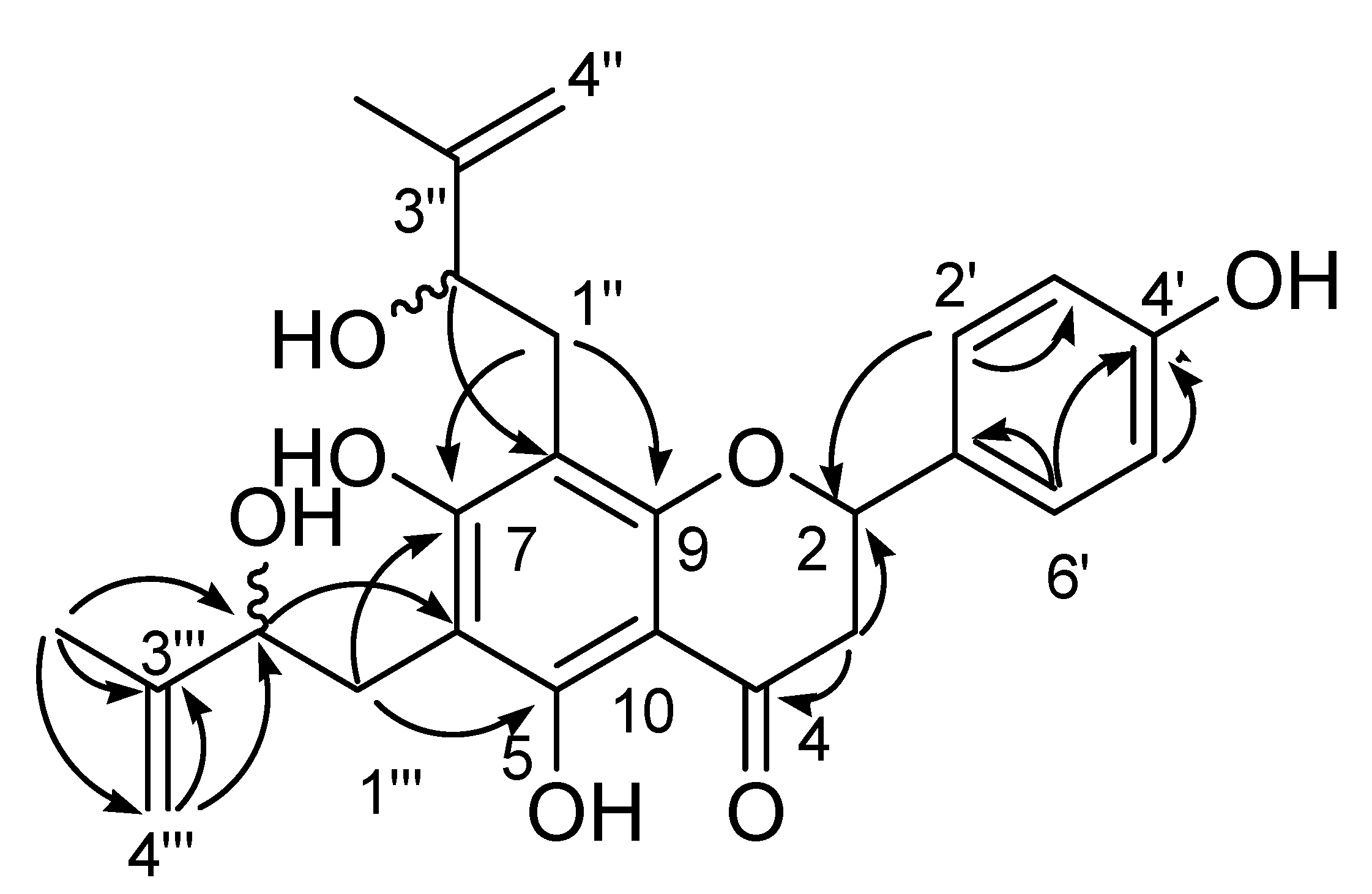A New Prenylated Flavanone from Derris trifoliata Lour.
Abstract
:1. Introduction
2. Results and Discussion

| Extract/Compound | LC50 ± S.D. (μg/mL) |
|---|---|
| Petroleum ether extract | 7.61 ± 1.62 |
| Ethyl acetate extract | 5.78 ± 1.18 |
| n-Butanol extract | >500.00 |
| Compound 1 | 211.31 ± 12.5 |
| Rotenone | 0.06 ± 0.03 |
| Tephrosin | 0.24 ± 0.05 |
| 12a-Hydroxyrotenone | 0.37 ± 0.15 |
| Deguelin | 0.73 ± 0.12 |
| 6a,12a-Dehydrorotenone | 9.95 ± 1.05 |
| Dehydrodeguelin | 5.32 ± 0.6 |
| 7a-O-Methyldeguelol | 2.75 ± 0.76 |
| 4'-Hydroxy-7-methoxyflavanone | 3.97 ± 0.63 |
3. Experimental
3.1. General
3.2. Plant Material
3.3. Extraction and Isolation
3.4. Brine Shrimp Assay
4. Conclusions
Supplementary Materials
Acknowledgements
References and Notes
- Shah, D.G.; Bhatt, S. First Record of the Mangrove Associate Derris Trifoliata Lour. from Gujarat. JBNHS 2008, 105, 359–360. [Google Scholar]
- Witt, J.D.; Warren, S.L.; Ranney, T.G.; Baker, J.R. Biorational and Conventional Plant Protectants Reduce Feeding by Adult Japanese Beetles. J. Environ. Hortic. 1999, 17, 203–206. [Google Scholar]
- Kirtikar, K.R.; Basu, B.D. Indian Medicinal Plants; International Book Distributors: Dehradun, India, 1987. [Google Scholar]
- Bhattacharyya, A.; Babu, C.R. Purification and Biochemical Characterization of a Serine Proteinase Inhibitor from Derris trifoliata Lour. Seeds: Insight into Structural and Antimalarial Features. Phytochemistry 2009, 70, 703–712. [Google Scholar] [CrossRef]
- Khan, M.R.; Omoloso, A.D.; Barewai, Y. Antimicrobial Activity of the Derris Elliptica, Derris Indica And Derris Trifoliata Extractives. Fitoterapia 2006, 77, 327–330. [Google Scholar] [CrossRef]
- Tewtrakul, S.; Cheenpracha, S.; Karalai, C. Nitric Oxide Inhibitory Principles from Derris trifoliata Stems. Phytomedicine 2009, 16, 568–572. [Google Scholar] [CrossRef]
- Yenesew, A.; Twinomuhwezi, H.; Kabaru, J.M.; Akala, H.M.; Kiremire, B.T.; Heydenreich, M.; Peter, M.G.; Eyase, F.L.; Waters, N.C.; Walsh, D.S. Antiplasmodial and Larvicidal Flavonoids from Derris trifoliata. Bull. Chem. Soc. Ethiop. 2009, 23, 409–414. [Google Scholar]
- Gomes, C.M.R.; Gottlieb, O.R.; Bettolo, G.B.M.; Dellemonache, F.; Polhill, R.M. Systematic Significance of Flavonoids in Derris and Lonchocarpus. Biochem. Syst. Ecol. 1981, 9, 129–147. [Google Scholar] [CrossRef]
- Mamoon, S.A.; Azam, M.G. Diuretic Activity and Brine Shrimp Toxicity of Derris trifoliata Lour. IJPLS 2011, 2, 1029–1032. [Google Scholar]
- Seo, E.K.; Silva, G.L.; Chai, H.B.; Chagwedera, T.E.; Farnsworth, N.R.; Cordell, G.A.; Pezzuto, J.M.; Kinghorn, A.D. Cytotoxic Prenylated Flavanones from Monotes engleri. Phytochemistry 1997, 45, 509–515. [Google Scholar] [CrossRef]
- Carlson, D.G.; Weislede, D.; Tallent, W.H. Nmr Investigations of Rotenoids. Tetrahedron 1973, 29, 2731–2741. [Google Scholar] [CrossRef]
- Andrei, C.C.; Viera, P.C.; Fernandes, J.B.; daSilva, M.F.D.F.; Fo, E.R. Dimethylchromene Rotenoids from Tephrosia candida. Phytochemistry 1997, 46, 1081–1085. [Google Scholar] [CrossRef]
- Magalhaes, A.F.; Tozzi, A.M.G.A.; Sales, B.H.L.N.; Magalhaes, E.G. Twenty-three Flavonoids from Lonchocarpus subglaucescens. Phytochemistry 1996, 42, 1459–1471. [Google Scholar] [CrossRef]
- Chantrapromma, S.; Fun, H.K.; Pullaput, Y.; Wongtap, H.; Dejmanee, S.; Chantrapromma, K. 7a-O-methyldeguelol. Acta Crystallogr. Sect. E Struct. Rep. Online 2005, E61, O2340–O2342. [Google Scholar]
- Cheenpracha, S.; Karalai, C.; Ponglimanont, C.; Chantrapromma, K. Cytotoxic rotenoloids from the stems of Derris trifoliata. Can. J. Chem. 2007, 85, 1019–1022. [Google Scholar] [CrossRef]
- Singhal, A.K.; Sharma, R.P.; Thyagarajan, G.; Herz, W.; Govindan, S.V. New Prenylated Isoflavones and a Prenylated Dihydroflavonol from Millettia pachycarpa. Phytochemistry 1980, 19, 929–934. [Google Scholar] [CrossRef]
- Lu, H.-Y.; Liang, J.-Y.; Yu, P.; Qu, W.; Zhao, L. Isoflavones and their Derivatives from the Root of Derris elliptica (Roxb.) Benth. Chin. J. Nat. Med. 2008, 6, 265–267. [Google Scholar] [CrossRef]
- Camarda, L.; Merlini, L.; Nasini, G. Novel 4-styrylflavans from Gum Accroides. Can. J. Chem. 1977, 30, 873–878. [Google Scholar]
- Barron, D.; Ibrahim, R. Isoprenylated Flavonoids-a Survey. Phytochemistry 1996, 53, 921–982. [Google Scholar] [CrossRef]
- Wanyoike, G.N.; Chhabra, S.C.; Lang’at-Thoruwa, C.C.; Omar, S.A. Brine Shrimp Toxicity and Antiplasmodial Activity of Five Kenyan Medicinal Plants. J. Ethnopharmacol. 2004, 90, 129–133. [Google Scholar] [CrossRef]
- Colman-Saizarbitoria, T.; Montilla, L.; Rodriguez, M.; Castillo, A.; Hasegawa, M. Xymarginatin: A New Acetogenin Inhibitor of Mitochondrial Electron Transport From Xylopia Emarginata Mart., Annonaceae. Rev. Bras. Farmacogn. 2009, 19, 871–875. [Google Scholar] [CrossRef]
- Alali, F.; Zeng, L.; Zhang, Y.; Ye, Q.; Craig Hopp, D.; Schwedler, J.T.; McLaughlin, J.L. 4-deoxyannomontacin and (2,4-cis and trans)-annomontacinone, new bioactive mono-tetrahydrofuran annonaceous acetogenins from Goniothalamus giganteus. Bioorg. Med. Chem. 1997, 5, 549–555. [Google Scholar] [CrossRef]
- Sample Availability: Samples of compounds 1–12 are available from the authors.
© 2012 by the authors; licensee MDPI, Basel, Switzerland. This article is an open-access article distributed under the terms and conditions of the Creative Commons Attribution license (http://creativecommons.org/licenses/by/3.0/).
Share and Cite
Jiang, C.; Liu, S.; He, W.; Luo, X.; Zhang, S.; Xiao, Z.; Qiu, X.; Yin, H. A New Prenylated Flavanone from Derris trifoliata Lour. Molecules 2012, 17, 657-663. https://doi.org/10.3390/molecules17010657
Jiang C, Liu S, He W, Luo X, Zhang S, Xiao Z, Qiu X, Yin H. A New Prenylated Flavanone from Derris trifoliata Lour. Molecules. 2012; 17(1):657-663. https://doi.org/10.3390/molecules17010657
Chicago/Turabian StyleJiang, Cheng, Shengzi Liu, Weihong He, Xiongming Luo, Si Zhang, Zhihui Xiao, Ximin Qiu, and Hao Yin. 2012. "A New Prenylated Flavanone from Derris trifoliata Lour." Molecules 17, no. 1: 657-663. https://doi.org/10.3390/molecules17010657
APA StyleJiang, C., Liu, S., He, W., Luo, X., Zhang, S., Xiao, Z., Qiu, X., & Yin, H. (2012). A New Prenylated Flavanone from Derris trifoliata Lour. Molecules, 17(1), 657-663. https://doi.org/10.3390/molecules17010657




